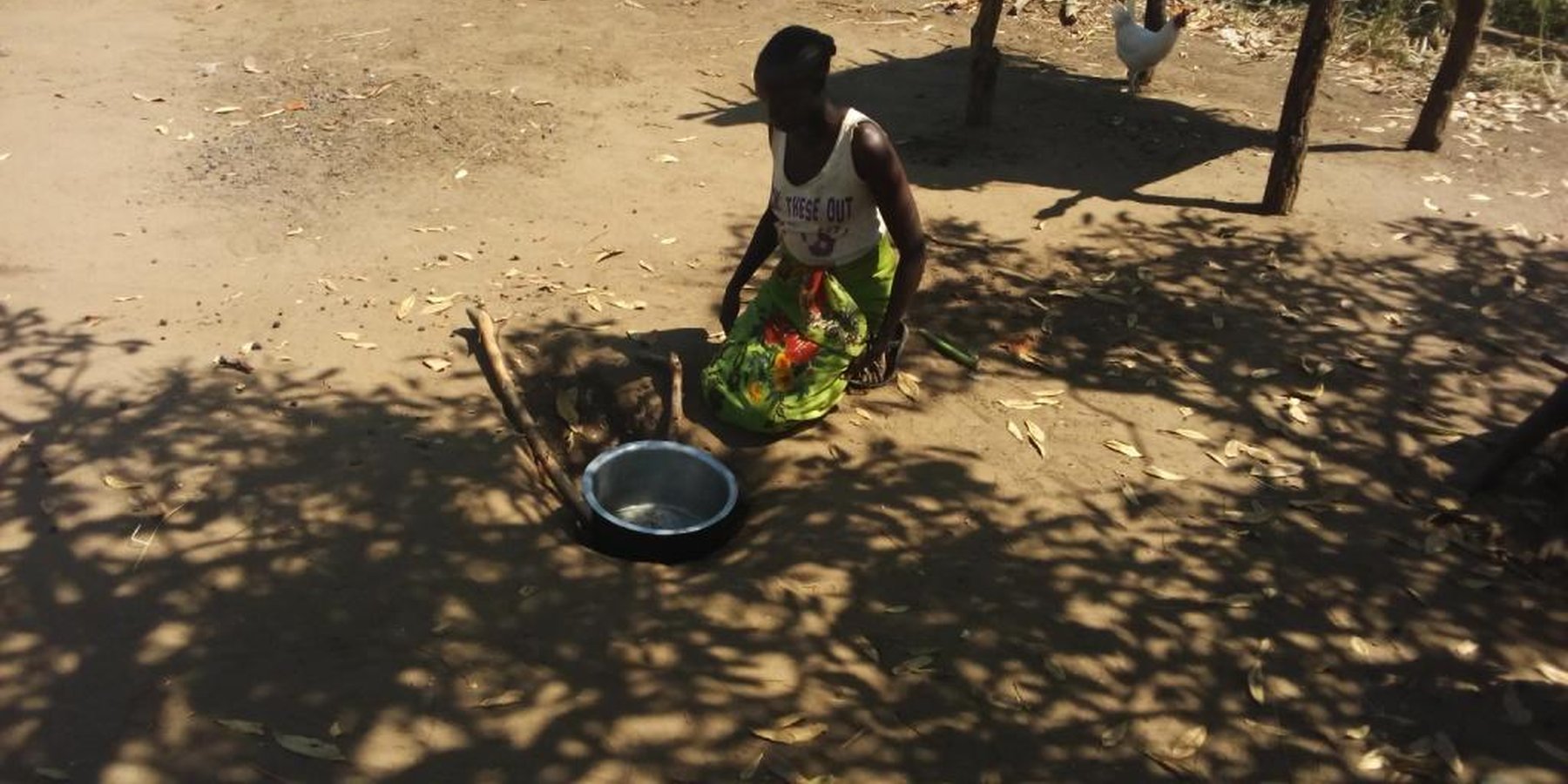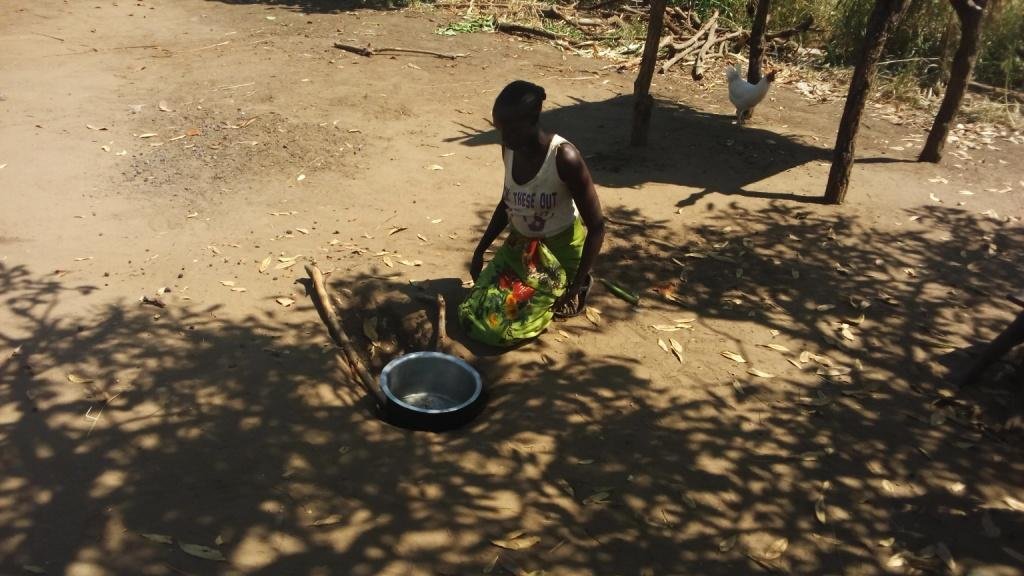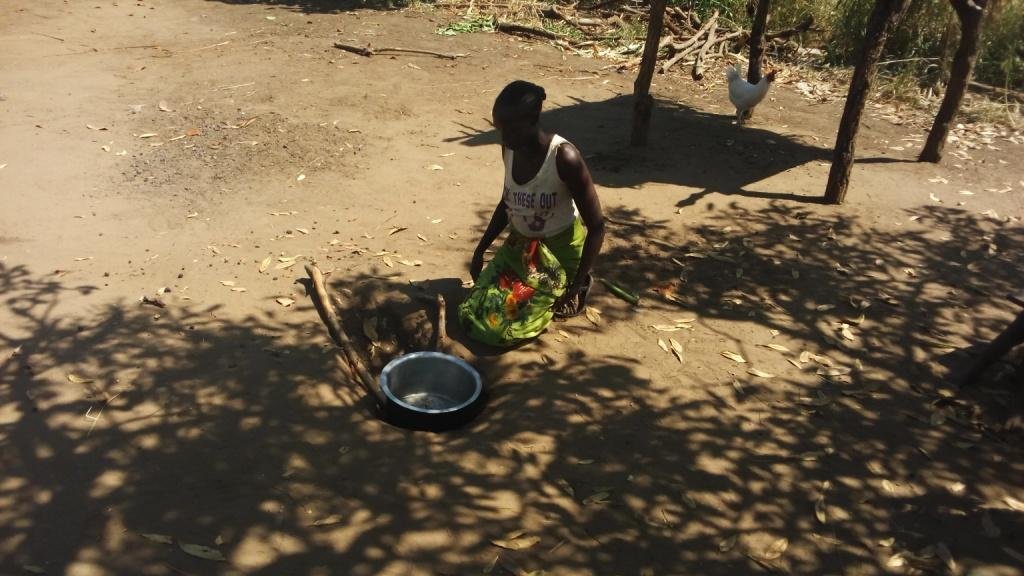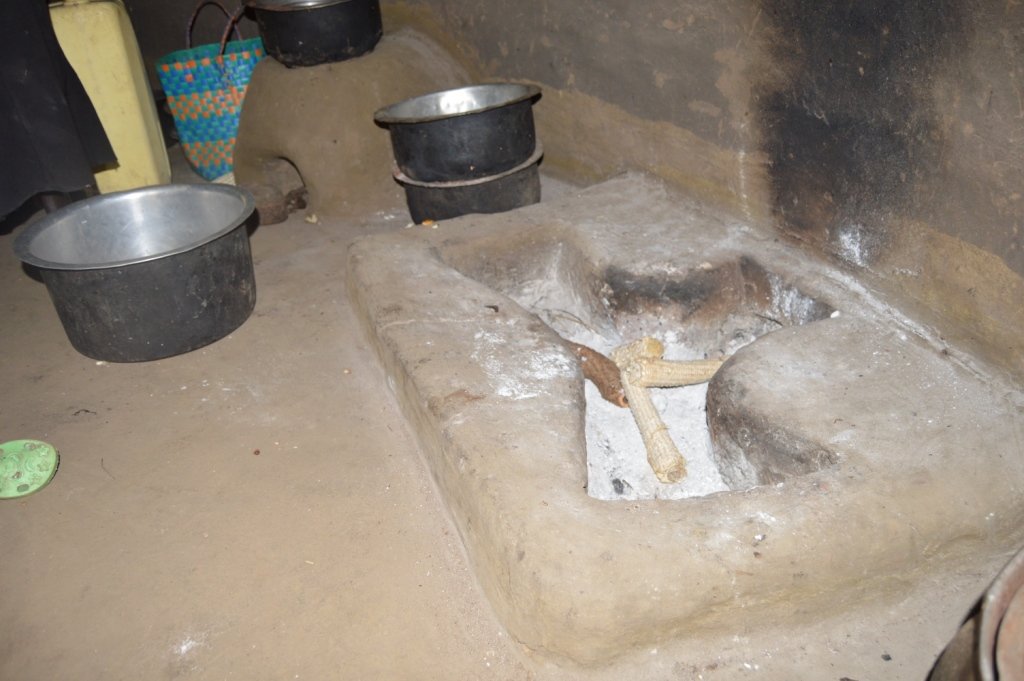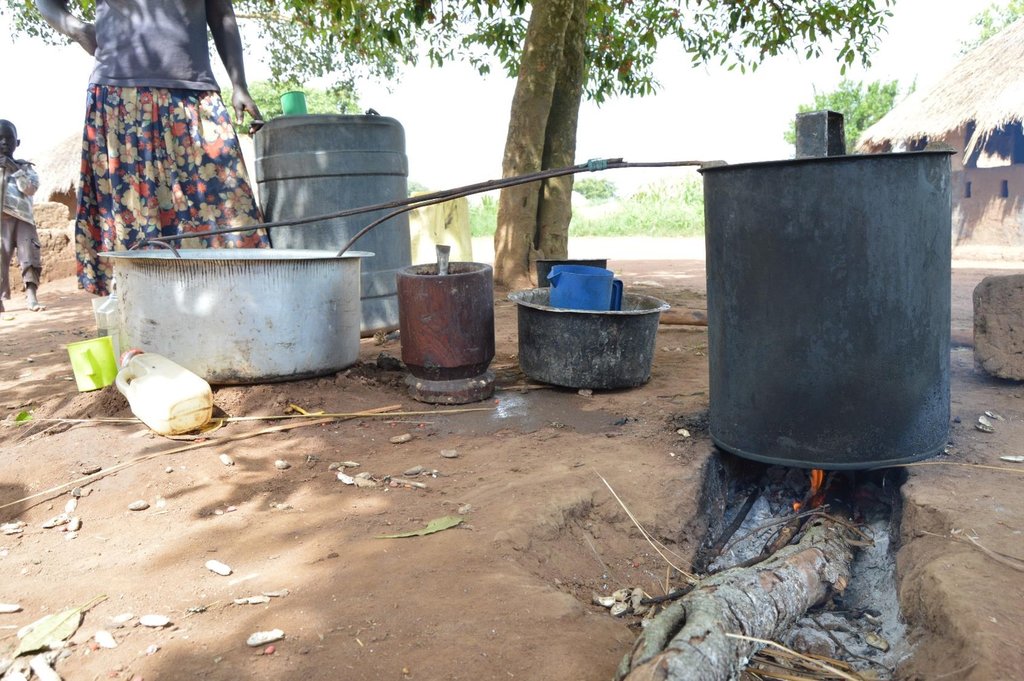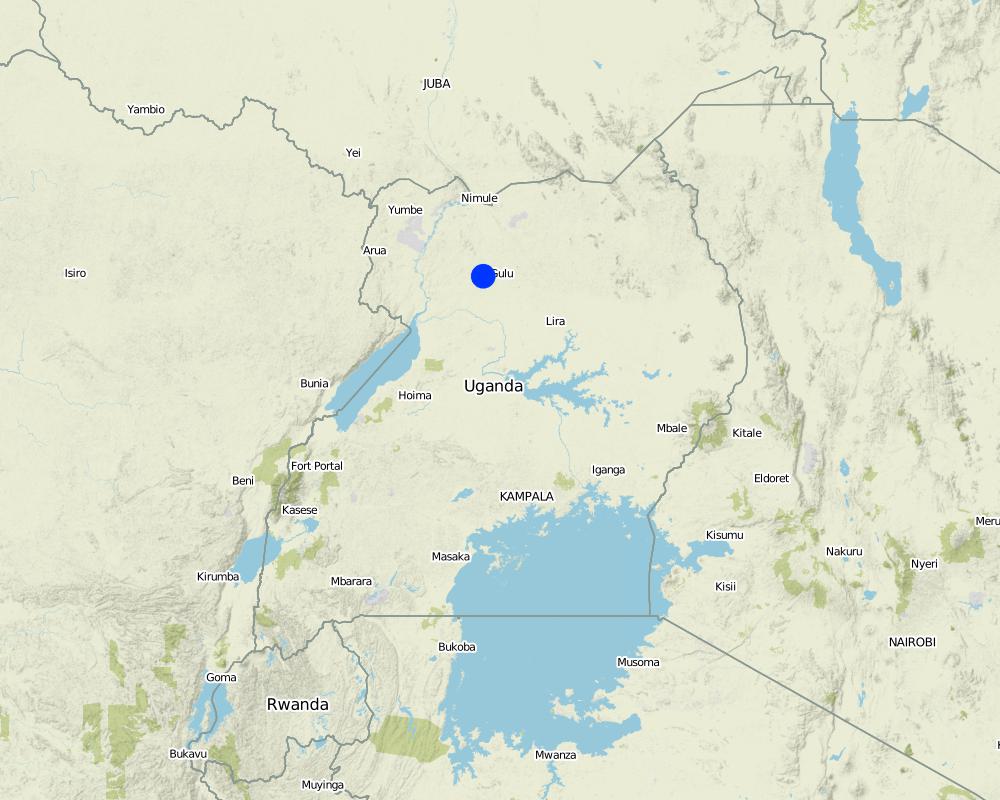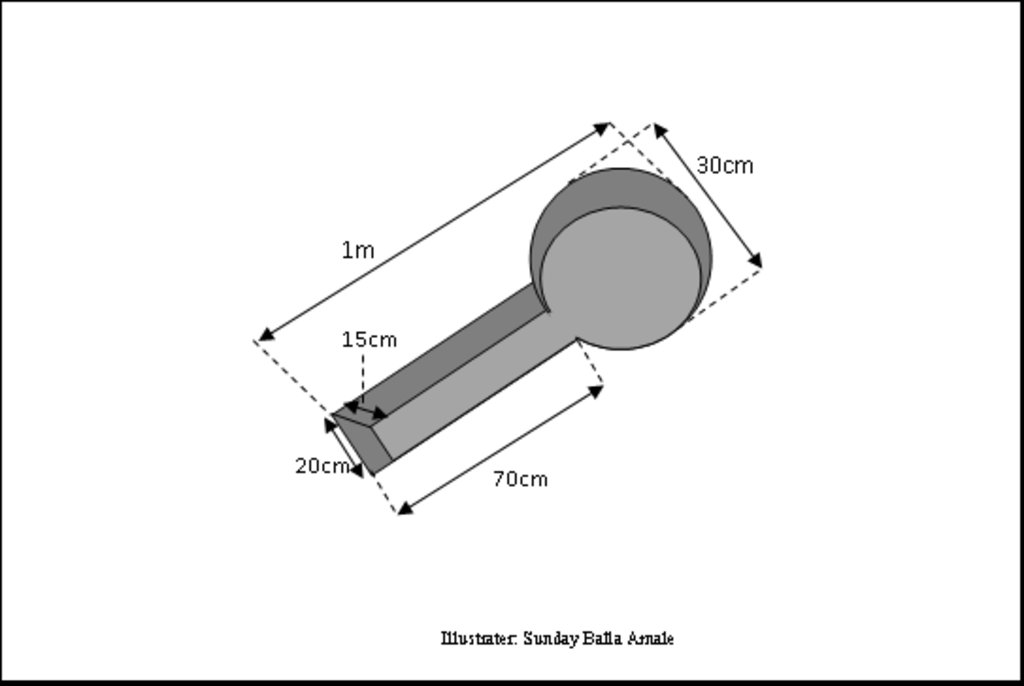Energy-saving ground stoves [Uganda]
- Creation:
- Update:
- Compiler: Sunday Balla Amale
- Editors: JOY TUKAHIRWA, Kamugisha Rick Nelson, betty adoch, Bernard Fungo
- Reviewers: John Stephen Tenywa, Nicole Harari, Alexandra Gavilano
keno di-ot (keno di-kal)
technologies_3324 - Uganda
View sections
Expand all Collapse all1. General information
1.2 Contact details of resource persons and institutions involved in the assessment and documentation of the Technology
Key resource person(s)
land user:
Ayamo Margret
Peasant farmer
Kweke, Langol Village, Panyabono Parish, Alero Sub-county, Nwoya District
Uganda
Name of project which facilitated the documentation/ evaluation of the Technology (if relevant)
Scaling-up SLM practices by smallholder farmers (IFAD)Name of the institution(s) which facilitated the documentation/ evaluation of the Technology (if relevant)
Uganda Landcare Network (ULN) - Uganda1.3 Conditions regarding the use of data documented through WOCAT
When were the data compiled (in the field)?
12/12/2017
The compiler and key resource person(s) accept the conditions regarding the use of data documented through WOCAT:
Ja
1.4 Declaration on sustainability of the described Technology
Is the Technology described here problematic with regard to land degradation, so that it cannot be declared a sustainable land management technology?
Nee
Comments:
This is a sustainable energy saving technology.
2. Description of the SLM Technology
2.1 Short description of the Technology
Definition of the Technology:
Energy-saving stove is a hole dug in the floor of a hut or in the compound. It helps to reduce the quantity of firewood used for cooking by reducing heat loss and ensuring firewood burning for longer time.
2.2 Detailed description of the Technology
Description:
The rate at which forests are disappearing in northern Uganda is so frightening that strategic ameliorative innovations such as reduced wastage of biomass energy need to be envisioned. As such, the technology known as “energy-saving ground stove or energy-efficient ground stove” is being promoted in the region. This technology ensures that (i) smoke is eliminated in the kitchen, thus achieving a healthy environment, (ii) cooking is done faster while the stove retains beat for longer periods, (iii) up to 60% of firewood used with traditional cooking stoves is saved, and (iv) accidents from open fires are prevented.The energy-saving ground stove is constructed by digging a hole inside the kitchen or in the compound. For domestic food preparation, the hole is usually 1 square meter and 15 cm deep. The end where firewood is inserted is about 20 cm wide; while the opposite end where the fire burns is about 30 cm wide. Sometimes, the ground hole is lined with a layer of clay on the floor and walls. During construction, the common wind direction should be noted, especially when the hole is constructed outside the house. Constructing this ground hole does not require much technical skill although making a good one requires some experience. A hand hoe is commonly used for digging the hole, but any ground excavating tool can be used. This technology helps to preserve heat in the soil for further cooking; thus reducing household demand for firewood considerably. Ultimately, this reduces the pressure on deforestation. It also substantially saves women farmers’ precious time, otherwise spent looking for firewood. This technology is particularly important for people who use firewood for cooking, because most energy- saving stoves available in the markets are expensive and require charcoal. Other locally made portable stoves also require charcoal. The challenge with the ground-stove technology is that it is not portable, hence, cannot be moved from one point to another. When constructed outside the kitchen, it becomes filled with water during rainy season, a factor that constrains its sustained use.
2.3 Photos of the Technology
2.4 Videos of the Technology
Date:
01/07/2018
2.5 Country/ region/ locations where the Technology has been applied and which are covered by this assessment
Country:
Uganda
Region/ State/ Province:
Nwoya
Further specification of location:
Anaka
Map
×2.6 Date of implementation
If precise year is not known, indicate approximate date:
- 10-50 years ago
2.7 Introduction of the Technology
Specify how the Technology was introduced:
- as part of a traditional system (> 50 years)
3. Classification of the SLM Technology
3.1 Main purpose(s) of the Technology
- reduce, prevent, restore land degradation
- conserve ecosystem
3.2 Current land use type(s) where the Technology is applied

Settlements, infrastructure
- Settlements, buildings
Comments:
Applied at cooking points or inside kitchen.
3.3 Further information about land use
Water supply for the land on which the Technology is applied:
- rainfed
Number of growing seasons per year:
- 2
Specify:
1st rain between mid march to june, 2nd rain between mid july to november
3.4 SLM group to which the Technology belongs
- energy efficiency technologies
3.5 Spread of the Technology
Specify the spread of the Technology:
- applied at specific points/ concentrated on a small area
Comments:
cooking points or kitchen
3.6 SLM measures comprising the Technology

structural measures
- S10: Energy saving measures
3.7 Main types of land degradation addressed by the Technology

biological degradation
- Bc: reduction of vegetation cover

other
Comments:
Deforestation since the pressure on wood cutting is reduced.
3.8 Prevention, reduction, or restoration of land degradation
Specify the goal of the Technology with regard to land degradation:
- reduce land degradation
- adapt to land degradation
4. Technical specifications, implementation activities, inputs, and costs
4.1 Technical drawing of the Technology
4.2 Technical specifications/ explanations of technical drawing
length 1m
burning end : round with diameter 30cm (depends on the purpose and sauce pan commonly used)
firewood input end 20cm (also depends on the purpose)
depth 15cm deep (depends on purpose )
4.3 General information regarding the calculation of inputs and costs
Specify how costs and inputs were calculated:
- per Technology unit
Specify unit:
hole
Specify volume, length, etc. (if relevant):
not applicable
other/ national currency (specify):
Uganda shillings
Indicate exchange rate from USD to local currency (if relevant): 1 USD =:
3600.0
Indicate average wage cost of hired labour per day:
5000 per day
4.4 Establishment activities
| Activity | Type of measure | Timing | |
|---|---|---|---|
| 1. | Identifying a suitable space | Management | anytime |
| 2. | Marking lot | Structural | anytime |
| 3. | digging holes | Structural | anytime |
Comments:
this cost has never been incurred as a person would simply perform the task himself or herself
4.5 Costs and inputs needed for establishment
| Specify input | Unit | Quantity | Costs per Unit | Total costs per input | % of costs borne by land users | |
|---|---|---|---|---|---|---|
| Labour | persons | person hours | 1.0 | 2000.0 | 2000.0 | 100.0 |
| Equipment | hand hoe | piece | 1.0 | 10000.0 | 10000.0 | 100.0 |
| Total costs for establishment of the Technology | 12000.0 | |||||
Comments:
for the cost of hand hoe, the land user maynot meet the cost since it may be available within the farmstead
4.6 Maintenance/ recurrent activities
| Activity | Type of measure | Timing/ frequency | |
|---|---|---|---|
| 1. | removing the ash | Other measures | once per week |
| 2. | shaping the corners | Structural | once a year |
Comments:
There are no recurrent activities except from reshaping the hole after 2-3 years when it will have lost shape.
4.7 Costs and inputs needed for maintenance/ recurrent activities (per year)
| Specify input | Unit | Quantity | Costs per Unit | Total costs per input | % of costs borne by land users | |
|---|---|---|---|---|---|---|
| Labour | personnel | person hours | 1.0 | 2000.0 | 2000.0 | 100.0 |
| Total costs for maintenance of the Technology | 2000.0 | |||||
4.8 Most important factors affecting the costs
Describe the most determinate factors affecting the costs:
price of the hoe
5. Natural and human environment
5.1 Climate
Annual rainfall
- < 250 mm
- 251-500 mm
- 501-750 mm
- 751-1,000 mm
- 1,001-1,500 mm
- 1,501-2,000 mm
- 2,001-3,000 mm
- 3,001-4,000 mm
- > 4,000 mm
Specifications/ comments on rainfall:
two rainy seasons separated by short dry spell between june and july. dry season between december to march
Indicate the name of the reference meteorological station considered:
Gulu
Agro-climatic zone
- sub-humid
5.2 Topography
Slopes on average:
- flat (0-2%)
- gentle (3-5%)
- moderate (6-10%)
- rolling (11-15%)
- hilly (16-30%)
- steep (31-60%)
- very steep (>60%)
Landforms:
- plateau/plains
- ridges
- mountain slopes
- hill slopes
- footslopes
- valley floors
Altitudinal zone:
- 0-100 m a.s.l.
- 101-500 m a.s.l.
- 501-1,000 m a.s.l.
- 1,001-1,500 m a.s.l.
- 1,501-2,000 m a.s.l.
- 2,001-2,500 m a.s.l.
- 2,501-3,000 m a.s.l.
- 3,001-4,000 m a.s.l.
- > 4,000 m a.s.l.
Indicate if the Technology is specifically applied in:
- not relevant
Comments and further specifications on topography:
applied in the homestead, compound or inside the house/hut
5.3 Soils
Soil depth on average:
- very shallow (0-20 cm)
- shallow (21-50 cm)
- moderately deep (51-80 cm)
- deep (81-120 cm)
- very deep (> 120 cm)
Soil texture (topsoil):
- medium (loamy, silty)
Soil texture (> 20 cm below surface):
- fine/ heavy (clay)
Topsoil organic matter:
- medium (1-3%)
5.4 Water availability and quality
Ground water table:
5-50 m
Availability of surface water:
medium
Water quality (untreated):
poor drinking water (treatment required)
Is water salinity a problem?
Nee
Is flooding of the area occurring?
Nee
5.5 Biodiversity
Species diversity:
- medium
Habitat diversity:
- medium
5.6 Characteristics of land users applying the Technology
Sedentary or nomadic:
- Sedentary
Market orientation of production system:
- subsistence (self-supply)
Off-farm income:
- less than 10% of all income
Relative level of wealth:
- poor
Individuals or groups:
- individual/ household
Level of mechanization:
- manual work
Gender:
- women
- men
Age of land users:
- youth
- middle-aged
5.7 Average area of land owned or leased by land users applying the Technology
- < 0.5 ha
- 0.5-1 ha
- 1-2 ha
- 2-5 ha
- 5-15 ha
- 15-50 ha
- 50-100 ha
- 100-500 ha
- 500-1,000 ha
- 1,000-10,000 ha
- > 10,000 ha
Is this considered small-, medium- or large-scale (referring to local context)?
- small-scale
Comments:
technology applied at household level
5.8 Land ownership, land use rights, and water use rights
Land ownership:
- individual, not titled
- individual, titled
Land use rights:
- individual
Water use rights:
- communal (organized)
Comments:
they have spring water for drinking
5.9 Access to services and infrastructure
health:
- poor
- moderate
- good
education:
- poor
- moderate
- good
technical assistance:
- poor
- moderate
- good
employment (e.g. off-farm):
- poor
- moderate
- good
markets:
- poor
- moderate
- good
energy:
- poor
- moderate
- good
roads and transport:
- poor
- moderate
- good
drinking water and sanitation:
- poor
- moderate
- good
financial services:
- poor
- moderate
- good
6. Impacts and concluding statements
6.1 On-site impacts the Technology has shown
Socio-economic impacts
Production
energy generation
Quantity before SLM:
collect fire wood once a week
Quantity after SLM:
collect firewood after every fortnight
Comments/ specify:
after SLM, little wood is required for their cooking activities
Income and costs
farm income
Comments/ specify:
increased since time spent in collecting firewood is put in farming
Socio-cultural impacts
farm land cultivated
Quantity before SLM:
2
Quantity after SLM:
2.5
Comments/ specify:
more time to work on farm
6.2 Off-site impacts the Technology has shown
impact of greenhouse gases
Comments/ specify:
efficient energy utilization
Comments regarding impact assessment:
This technology has indirect impacts on reducing land degradation.
6.4 Cost-benefit analysis
How do the benefits compare with the establishment costs (from land users’ perspective)?
Short-term returns:
positive
Long-term returns:
very positive
How do the benefits compare with the maintenance/ recurrent costs (from land users' perspective)?
Short-term returns:
positive
Long-term returns:
very positive
6.5 Adoption of the Technology
- 10-50%
Of all those who have adopted the Technology, how many have did so spontaneously, i.e. without receiving any material incentives/ payments?
- 90-100%
Comments:
usually common among people brewing alcohol
6.6 Adaptation
Has the Technology been modified recently to adapt to changing conditions?
Nee
6.7 Strengths/ advantages/ opportunities of the Technology
| Strengths/ advantages/ opportunities in the land user’s view |
|---|
| Less time needed for collecting firewood since wood demand is reduced. |
| Reduced cutting down of trees since demand for firewood is reduced. |
| Heat stored in the ground makes food cook very fast. |
| After cooking, the heat in the soil is used to roast sweet potatoes or cassava. |
| Strengths/ advantages/ opportunities in the compiler’s or other key resource person’s view |
|---|
| The technology is cheap and does not require technical skills. |
| It can easily be scaled up to highly populated areas since it takes up a very small space. |
| The technology is cheaper than any portable energy saving stoves available in the market. |
6.8 Weaknesses/ disadvantages/ risks of the Technology and ways of overcoming them
| Weaknesses/ disadvantages/ risks in the land user’s view | How can they be overcome? |
|---|---|
| Cannot be moved from one point to another. | |
| If in the compound, rainwater clogs inside it. | Cover it with carpet during rain. |
| Weaknesses/ disadvantages/ risks in the compiler’s or other key resource person’s view | How can they be overcome? |
|---|---|
| Corners need shaping over time. | Use clay to stabilise corners of the ground hole. |
7. References and links
7.1 Methods/ sources of information
- field visits, field surveys
1
- interviews with land users
2 farmers
- interviews with SLM specialists/ experts
1
Links and modules
Expand all Collapse allLinks
No links
Modules
No modules


